Tour de Greece – Greece day by day – part 1
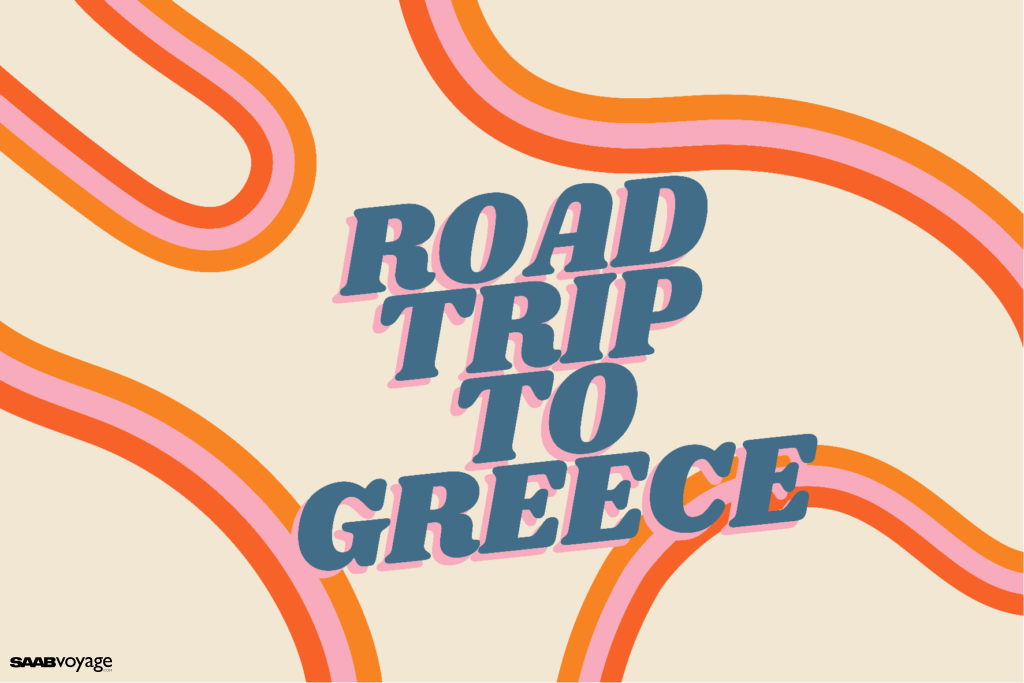
Index
Introduction
Yellow Crocodile, Saab 900 Cabrio, just like last year, is our holiday car. There’s no denying that it’s a perfect car for trips to warm countries, even though it comes from Sweden. So it was with us on Gotland, Hungary or simply on the Covidian Tour de Pologne in previous years.
We have collected our notes, notes, and thoughts from this year’s trip to Greece. From the beginning, we planned the trip as a car trip. Our goal was to get to the continental part of the country. However, a key element in planning the route was how easy it would be to change it due to the pandemic and the fires that swept through Greece this year more than in previous years.
There will be at least three separate notes introducing this trip.
There is too much content for one. This country has too many attractions.
This will not be a typical guide. There are much better than us who can tell you historical and geographical facts. So instead, here, we will share our subjective impressions. We hope that you will find them helpful and that they will bring your holiday trip to Greece via Romania and Bulgaria a bit closer. And also return via North Macedonia, Serbia, and Hungary.
Greece has the advantage in this day and age (2021) of being densely covered with exciting sights. In other words, if you fancy a trip into Greek Mythology, this is a good destination. So in the short term, we can design a good trip. The main logistical hassle is working out a cost-optimal route in the area of accommodation.
Although we prepared the trip well in advance, many cheaper places were already booked at the beginning of the year. And, unfortunately, in uncertain times, it is challenging to plan further in advance when you are not even sure from which side you will be entering.
Here it’s easy to make a mistake that can affect your budget. On the spot, prices reflect the peak season, and it isn’t easy to find a free place. But, on the other hand, if you decide to change your stopping place, it may involve night driving in the mountains, where, despite good roads, you cannot count on good lighting. This translates into a low average speed, and that on time.
Friday – Poland
Here we go. 6 August 2021. Warsaw.
This year everything went so well that on Thursday, we were completely packed.
The only thing missing was the people in the car.
As usual, our trip started on Friday after work. As usual, around 6 pm, we took off for our first stopover point, Krakow. We have two places in this direction that we know how to get to on autopilot: Krakow and Katowice. A good base for accommodation is Novotel. There we can always count on a solid breakfast, admittedly this time in the Covidian version. But already at the tables.
Saturday – Hungary and Romania
Our direction is Miskolc. There we planned a stop for langos. Navigation led us through Nowy Wiśnicz and Piwniczna. Not a soul was to be seen on the border crossing between Poland and Slovakia.
We dashed through Slovakia, the navigation led us along narrow, more or less potholed roads, and then we realised we were in Hungary.
On the way, google maps showed that the best langoš are not in Miskolc but the village below. It is worth remembering the location:
It is not possible to pay by card, but an ATM is 400 m away towards the town centre.
As planned, we spent the night in Oradea, in a typical Romanian flat available on booking.com. The lady owner delegated her mother, who only knew Romanian and waved hands, to hand over the keys. But we got along. Here we already felt that we were heading for the hot south. It was hot and stuffy at night. There were only small fans in the flat to stir the air, which was thick as jelly.
There was a queue at the HU->RO border. We had to show our documents (identity cards) and say where we were going.
Sunday – Romania
We drove on, south-eastwards, towards Bucharest. Then, suddenly, we went through a town with such a lovely castle.

Then we headed through Huedin, a village that stands out from the rest by the presence of many Romani palaces.
Crossing the Carpathians was an exciting experience for us. First of all, it was hampered (i.e. helped as much as it could, but the traffic jam situation was highly variable) by our unrelenting navigation with online/live data, which kept changing its mind – because the conditions were changing minute by minute. Nevertheless, we drove across the river, through dams, dodged traffic jams, admired mountain views, and finally managed to break through to the south.
We noticed an interesting phenomenon: we are driving along a winding road in the mountains and suddenly, in the middle of nowhere, at a bend, there is a pub and souvenir stalls – an incredible view.
On the highway towards Bucharest, despite the difficulties at the borders, we met many cars with foreign plates:
- Italians,
- Belgians,
- a Spaniard,
- a Swede (he waved back even though he was driving a Ford),
- Bulgarian,
- Lithuanians,
- Poles,
- Slovaks,
- Czechs,
- Germans,
- Austrians,
- Swiss.
Finally, in Bucharest, we could socially fulfil ourselves, meeting a colleague from work, together with a woman. Greetings!
A metre of beer later, we concluded that both nations make the same mistakes in democracy. That, in a nutshell, summarises our reflections on the similarities and differences of our countries, which joined the European Union in the same year. The changes from year to year are visible to the naked eye. However, they are significantly different in both countries.
Meanwhile, we hear from the Saab world that the Estonian team in the 9-3 are finishing licking their wounds after a burnt radiator fan, also on their way to Greece. As far as we know, they made it safely.
After the second day in the warmth, as we do every year when riding without a roof, we have already the first conclusion: it is necessary to apply sunscreen. Moreover, our new personal windschott is up to the task. In such temperatures, hydration is critical; food is secondary.
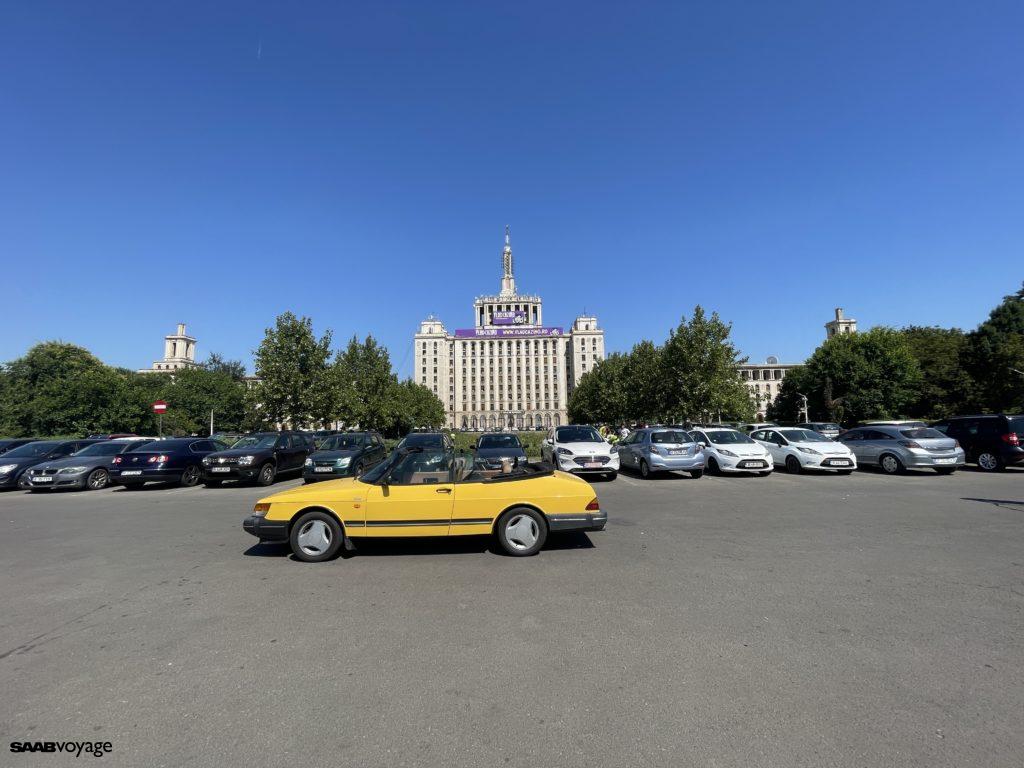
As road trivia, we met in Romania several Porsche Boxters on Romanian plates, one Tesla, one Niva and only one Saab.
As far as driving in Bucharest is concerned, it is dynamic and fast, but common sense. It gets better every year. You don’t see any bumps or damaged cars.
Monday – Romania and Bulgaria
We planned to test our daughters for covid already on the trip. Having a current negative certificate was required to enter Bulgaria and Greece.
While still in Poland, we booked an appointment online in Bucharest for a COVID test.
At the window, we met an implacable lady who absolutely had to have a stationary Romanian address, which of course, we didn’t have because we were only passing through. We gave her the address where we were (!), the address of the clinic. She accepted it without stammering or blinking. Generally, the formalities took longer than the test itself. I guess the procedures here did not cater for an unusual case like us, namely foreigners.
A bridge over the Danube marks the border between Romania and Bulgaria. Nobody wanted anything from us at the border crossing. And the only human contact was the toll for crossing the bridge.
We went on a sightseeing tour of Sofia. An interesting city. The guidebooks get excited about Orthodox churches. Meanwhile, in the centre, on the occasion of the construction of the metro, the ruins of the city from Roman times were discovered. The ruins have been nicely protected and integrated into the architecture of the town. For the natives, it was nothing special and nothing to get excited about. It made an impression on us.
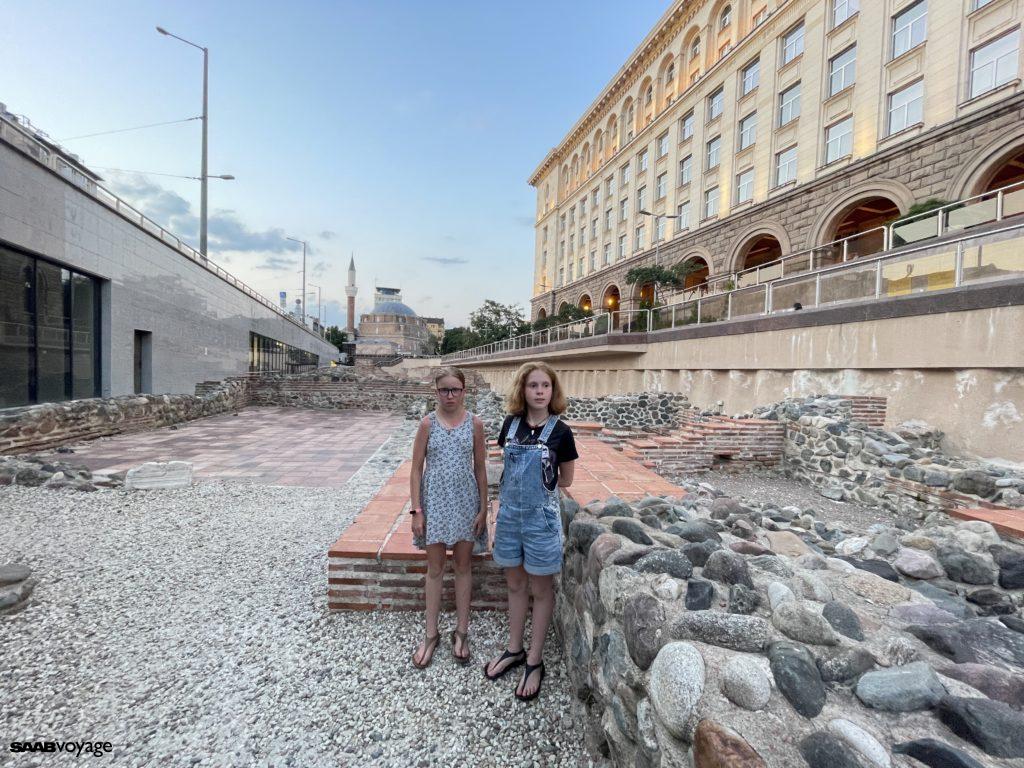
We ended the day in a restaurant with local cuisine. Interestingly, the Ćevapi we know from Serbia and Bosnia and Herzegovina are called кебапчета (kebapczeta) here.
Wtorek – Bułgaria i Grecja
In Sofia, we had two more missions to complete. The first succeeded half-heartedly – there was no full-sized Bulgarian mug in Starbucks, but there was a miniature. Always something. We’ll have to go back for the big one.
The second objective was to see the oldest dome in the city. It’s an interesting building. Originally it was a Roman rotunda, then it was converted into an Orthodox church, then into a mosque, and finally, it is an Orthodox church again. It was renovated with funds from Daewoo and Sheraton.
There is a motorway from Sofia to Thessaloniki (in fact, it runs from Miskolc to Thessaloniki), which unexpectedly breaks off, only to return some time later. This is because work on the road has stopped. The problem is that the only technically possible route passed through a protected area (Natura 2000) and was protested. Another project envisaged building a tunnel, which was also protested against, including by construction companies. The third project envisages splitting the two strands of motorway and using different routes. This is not to the liking of local business owners and environmentalists either. However, we saw construction work in progress as we drove along, so perhaps a compromise has been agreed.
You can read about the history of the construction of this motorway and its current status here.
We arrived at the Bulgarian-Greek border. At last, the documents came in handy; we had to show our covid pass, our daughter’s negative tests, and a completed registration form. At the border… it went smoothly once someone had everything ready. Unfortunately, most of the people waiting were completely surprised by this, so we were stuck in line for an hour. Interestingly, there was a test point at the border for those who wanted to cross but didn’t meet the requirements.
For the evening, we arrived at Thessaloniki. We left the finish line of Zlombol on the Chalcidian peninsula. A stop at the border used up our time reserve, and besides, the wall of heat in the mountains (36-37 degrees) started to heat up the car, so at times we drove slower than we had anticipated. I.e. at the time, we thought that when the temperature pointer vibrated upwards, it was a reason to panic and get excited. In practice, the arrow went up and down for the rest of the trip in Greece, which was basically in line with how the cooling system worked. And it was working correctly. Fortunately, we had already assumed at the outset, as we always assume a +10% surcharge on the time of arrival. And that again was a reasonable assumption.
Wednesday – Greece at last!
For a start, we experienced the Greek approach to COVID: if you want to sit in a pub (it’s nice, the air conditioning is blowing), then show a COVID PASS. Don’t want to show it? Sit in the garden.
All in all, when there are no national restrictions (type: we only accept Greek covid passages), it suits us.
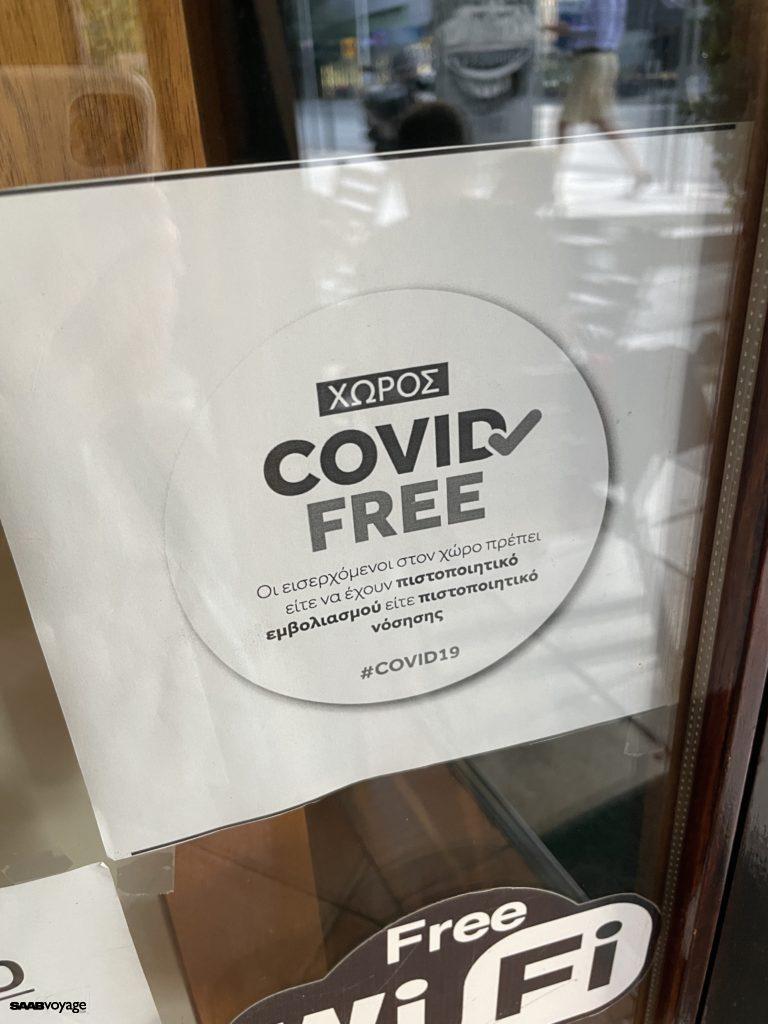
The second issue, which turned out to be characteristic of the whole of Greece later on, but we felt it for the first time in Thessaloniki: there is a huge parking problem here.
Anyone who advises you to book accommodation, including parking, is right. There are absolutely no vacancies here and the “I’ll find something on the spot, even pay” approach doesn’t stand a chance.
Generally, driving a car around Thessaloniki is pointless. And in a campervan, it’s an entirely crazy idea—lots of narrow, one-way roads, drivers with imagination (we will write about this later).
We decided to feel like real tourists and used the hop-on-hop-off bus. It was our debut 🙂 We did the first familiarization round first, and then on the same ticket, we went up here and there.
We felt almost like kids from smaller towns who rode the lift in blocks of flats.
There were cats everywhere in Thessaloniki (as we later found out, cats are all over Greece). We noticed that they are fed cat food by the locals. But they are unlikely to have affectionate caretakers who will take them to the vet if they need it.

The seaside boulevard in Thessaloniki looks like Nice in Greek – with a mess. The sight of locals digging rubbish into the sea for a joke offended us terribly.
Another Thessaloniki picture: the city has started to build a metro; you can look into the excavations and see the old Greek building basements. It was the beginning of our trip, so the ancient stones still impressed us, later we got pickier.
In the context of COVID, we were touched by the fact that in the Basilica of St Dimitrios, every second chair had its seat removed. So that you actually had to keep your distance. How simple and effective.
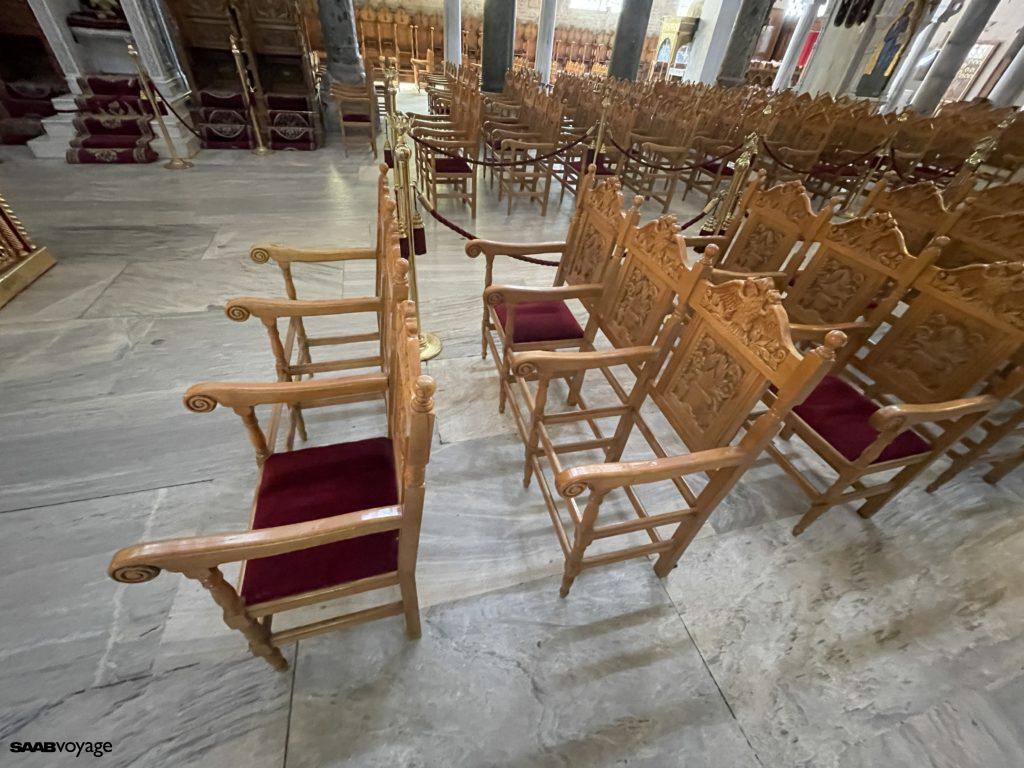
Aristotle Square is the public centre of the city. In front of the statue of the philosopher, local kids kick a ball around while tourists look at the sea and sip frappe.
We, however, preferred to go a few blocks deeper where the locals go. So we ended up in the usual Greek fruit and vegetable shops (you can’t necessarily pay by card).
In general, in the areas not frequented by tourists, there are a lot of service outlets, both open and closed: a shoemaker, a locksmith, a car lamp shop, and everything as dusty as in an open-air museum.
Looking into alleys, bushes and holes can lead to exciting discoveries; you can see an amphitheatre hidden behind a fence or a 1000-year-old church.
For the sake of order, below is a list of sights we think are worth seeing in Thessaloniki:
- Basilica of St. Dimitri
- Greek Agora and Roman Forum
- Triumphal Arch
- White Tower
- Heptapyrgion (fortress above the city)
Thursday – Vergina
Leaving Thessaloniki, we drove up to the White Tower (closed unexpectedly the day before) to take a photo of the car and then to the fortress above the city. Unfortunately, the fortress, although huge, does not impress.
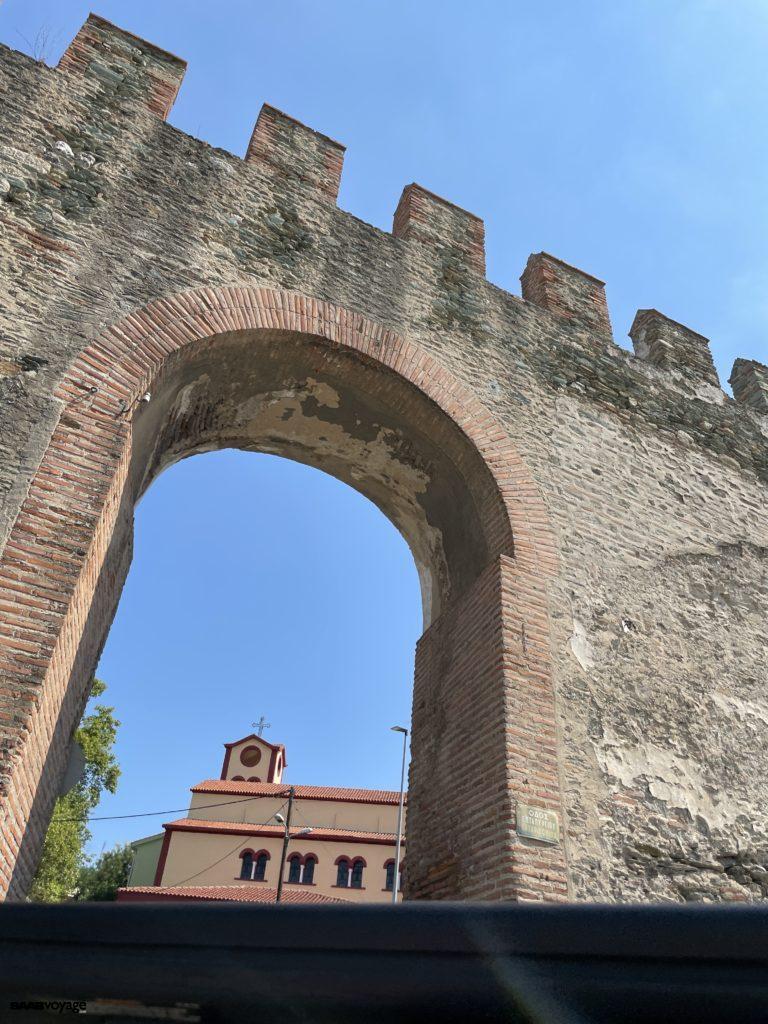
We went to Vergina. This is an absolutely essential point on the itinerary of anyone interested in ancient history.
The ancient city of Ajgaj, capital of the kingdom of Macedonia, existed on this site. From the perspective of Greek history, this site is crucial. Interestingly, it was only in 1977 that the tombs of rulers were discovered here, including Philip II himself, the father of Alexander of Macedon. The tombs were complete, with inhabitants and all equipment.
The museum itself is located inside the barrows. On display are sarcophagi, golden wreaths, ornaments, and gifts placed in the tombs.
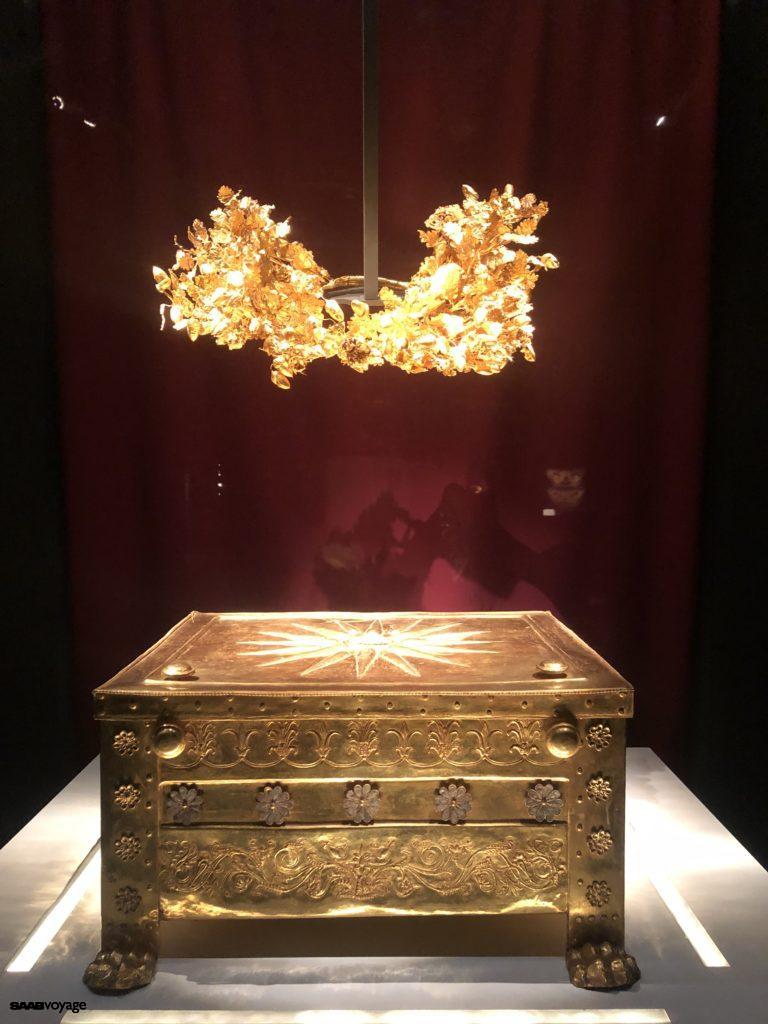
Pandemic: there is a limit on the number of people inside: 40 people. When you buy a ticket, you get your number and have to wait to be called. We waited for about an hour.
This is the first time we have encountered a situation where staff suggest respectful and dignified behaviour. It is not appropriate to take a selfie with a tombstone or a coffin containing the mortal remains of a ruler. But photos, as such, are possible.
Hint: it’s worth buying a magnet with the Star of Macedonia here, as it can be a problem later on.
We bought fig-flavoured ice cream in a local grocer – no speciality, just a curiosity. Just like figs growing on trees in Ajgaj.
We drove along the motorway to the southwest. On this particular stretch, there were proper rest areas for drivers, i.e. with tables. You may or may not know, but we have a habit of eating soup on the way. So here we had somewhere to set up our handy kitchen. After that, there was no way.
We arrived in Kalabaka, a town at the foot of the Meteora.
In the local market, we bought tomatoes, cucumbers, feta, oil. We felt like real Greeks 🙂
Pomegranates are growing in the street. We asked the lady from the property next door if we could pick one. She did not chase us away but advised us which would be best.
In the evening, the city comes alive; people sit in pubs and talk instead of sitting in front of their TV sets.
It’s a pity that this is not the case in Poland; here, you get water for free at the start, and various interesting snacks (cheese, fruit, nuts) are served with beer.
To be continued…